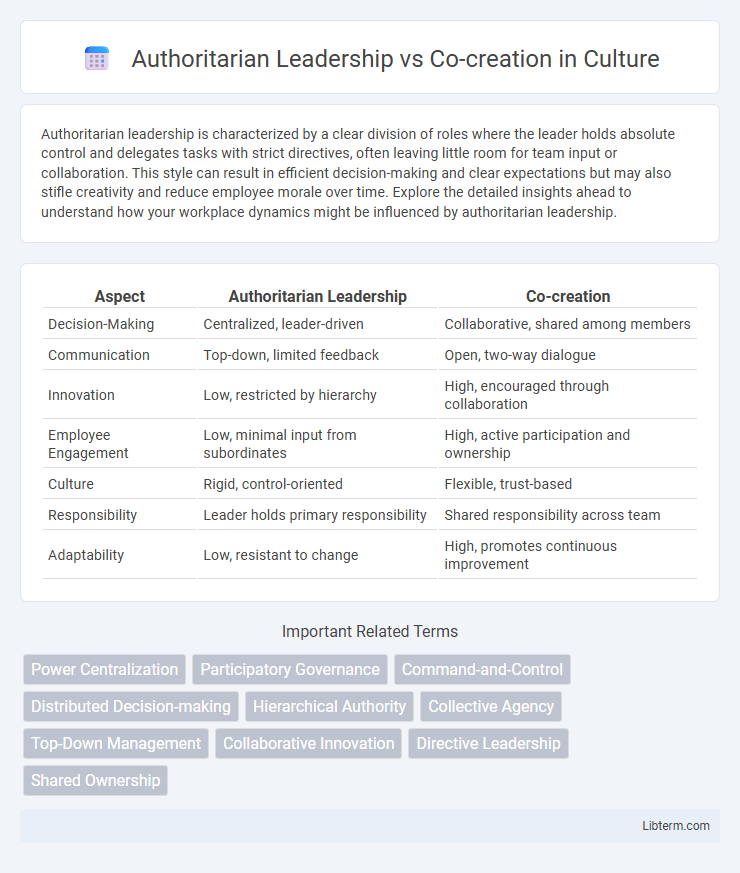Authoritarian leadership is characterized by a clear division of roles where the leader holds absolute control and delegates tasks with strict directives, often leaving little room for team input or collaboration. This style can result in efficient decision-making and clear expectations but may also stifle creativity and reduce employee morale over time. Explore the detailed insights ahead to understand how your workplace dynamics might be influenced by authoritarian leadership.
Table of Comparison
| Aspect | Authoritarian Leadership | Co-creation |
|---|---|---|
| Decision-Making | Centralized, leader-driven | Collaborative, shared among members |
| Communication | Top-down, limited feedback | Open, two-way dialogue |
| Innovation | Low, restricted by hierarchy | High, encouraged through collaboration |
| Employee Engagement | Low, minimal input from subordinates | High, active participation and ownership |
| Culture | Rigid, control-oriented | Flexible, trust-based |
| Responsibility | Leader holds primary responsibility | Shared responsibility across team |
| Adaptability | Low, resistant to change | High, promotes continuous improvement |
Understanding Authoritarian Leadership: Key Traits and Practices
Authoritarian leadership is characterized by centralized control, clear directives, and a top-down decision-making approach that emphasizes obedience and discipline. Key traits include a strong leader who demands compliance, limited employee input, and strict adherence to established rules and procedures. This leadership style often results in quick decision-making but can stifle creativity and reduce employee engagement compared to collaborative approaches like co-creation.
What is Co-creation? Definitions and Core Principles
Co-creation is a collaborative process where leaders and team members jointly contribute ideas, knowledge, and skills to generate innovative solutions and shared value. Core principles of co-creation include active participation, mutual respect, transparency, and equal partnership, fostering an environment where diverse perspectives drive creative problem-solving. Unlike authoritarian leadership, co-creation emphasizes empowerment, open communication, and collective ownership of outcomes.
Comparing Decision-Making Styles: Top-Down vs Collaborative
Authoritarian leadership relies on top-down decision-making, where leaders unilaterally set goals and dictate actions, ensuring swift execution but limiting team input and innovation. Co-creation embraces a collaborative decision-making style, engaging diverse stakeholders in ideation and problem-solving processes to foster shared ownership and creativity. Organizations prioritizing agility and employee empowerment often benefit from co-creation's inclusive approach over the hierarchical rigidity of authoritarian models.
The Impact on Team Performance: Efficiency vs Innovation
Authoritarian leadership drives team efficiency through clear directives and strict control, resulting in fast decision-making and consistent task completion but often limits creative input. In contrast, co-creation fosters innovation by encouraging collaborative problem-solving and diverse perspectives, enhancing adaptability but sometimes slowing down processes. Teams under co-creation models demonstrate higher engagement and novel solutions, whereas authoritarian teams excel in predictable, routine environments requiring rapid execution.
Employee Engagement: Compliance or Empowerment?
Authoritarian leadership often drives employee engagement through compliance, emphasizing strict control and directive communication that limits autonomy. In contrast, co-creation fosters empowerment by involving employees in decision-making, enhancing motivation, and promoting innovation. Studies show empowered employees under co-creation models exhibit higher job satisfaction, commitment, and productivity compared to compliance-driven environments.
Conflict Resolution: Directive Control vs Shared Solutions
Authoritarian leadership resolves conflicts through directive control, emphasizing top-down decisions that enforce immediate compliance and maintain strict order. In contrast, co-creation approaches conflict resolution by fostering shared solutions, encouraging collaborative dialogue and mutual understanding to address underlying issues. This shift from unilateral command to collective problem-solving enhances team engagement and sustainable conflict management.
Adaptability to Change: Static Hierarchy or Dynamic Flexibility
Authoritarian leadership often relies on a static hierarchy that limits adaptability to change due to centralized decision-making and rigid control structures. In contrast, co-creation promotes dynamic flexibility by encouraging collaboration, diverse input, and shared ownership of ideas, enabling organizations to respond swiftly to evolving challenges. Emphasizing adaptability, co-creative environments harness collective intelligence, fostering innovation and resilience in rapidly changing markets.
Real-World Examples: Success and Failure Stories
Authoritarian leadership, exemplified by Steve Jobs at Apple during product launches, often drives rapid decision-making but risks stifling creativity and employee morale, as seen in early Apple product delays and team burnout. In contrast, co-creation models like LEGO's open innovation platform foster collaborative innovation, leading to successful product lines and strong customer loyalty, yet require effective facilitation to avoid slow decision cycles. Companies embracing co-creation, such as Google with its employee-driven projects, highlight how shared leadership and input can spur breakthrough innovations, whereas rigid authoritarian structures may fail to adapt swiftly to market changes.
Organizational Culture: Fear-Based vs Trust-Based Environments
Authoritarian leadership fosters a fear-based organizational culture characterized by strict control, limited employee autonomy, and communication barriers, which hampers innovation and engagement. In contrast, co-creation thrives in trust-based environments where transparent communication, collaboration, and shared decision-making empower employees and drive collective creativity. Organizations embracing trust-based cultures report higher job satisfaction, increased retention rates, and enhanced adaptability to change compared to those dominated by fear-based systems.
Choosing the Right Approach: Factors to Consider
Choosing between authoritarian leadership and co-creation depends heavily on organizational culture, team expertise, and the complexity of the task. Authoritarian leadership suits high-pressure situations demanding quick decision-making and clear directives, while co-creation thrives in environments valuing innovation, diverse input, and collaborative problem-solving. Analyzing factors such as the urgency of goals, stakeholder involvement, and communication dynamics ensures alignment with the most effective leadership style for sustainable success.
Authoritarian Leadership Infographic

 libterm.com
libterm.com